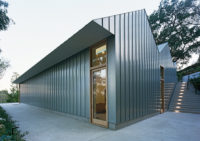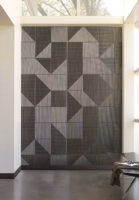An unforgettable concert or theater piece requires more than great artists. Crafting a space with an eye toward the acoustics, the audience experience, and players’ needs can heighten the quality and intensity of the events held within its walls. With these three international venues, design considerations for all the senses take center stage.
National Sawdust, Brooklyn
According to New York–based architecture firm Bureau V, how an audience perceives National Sawdust’s physical space is as important as the musical events held there. The journey begins in the lobby, which is clad in black ceramic tile from Design & Direct Source. This transition area “juxtaposes the building’s gritty, postindustrial exterior with its jewel-like interior,” says firm principal Peter Zuspan. A 10-foot-square acoustic door custom made by Clark Door slides into the ceiling for a dramatic reveal of the double-height performance space.
Inside, faceted panels of acoustic-speaker fabric and perforated aluminum—fashioned by the local Seetin Design Group—give the room an intimate feel. “We wished to create a soft, patterned envelope that would wrap the audience and become part of each performance,” Zuspan explains. Fluorescent fixtures from Bartco MiT8 provide warm house lighting, while linear Plexineon LED strips from iLight Technologies placed in recessed channels, offering discreet, consistent illumination.
Sponsored By Tamlyn
The performance hall has no trap doors, curtains, or wings: It’s a single open space. Nivoflex and Steeldek helped design the flexible stage system, which is composed of a dozen 3-by-6-foot platforms that can rise independently from the floor. The entire stage—or parts of it—can ascend or disappear as needed, allowing performers and their audience to explore new dynamics of interaction.
Taylor Centre for the Performance Arts, Mount Royal University, Calgary, Alberta
“We wanted a multipurpose concert hall for all types of music,” says Pfeiffer Partners principal William Murray of Bella Concert Hall, part of Mount Royal University’s Taylor Centre for the Performing Arts. The Los Angeles– and New York–based firm created the 773-seat space for the Western Canadian institute in association with local practice Sahuri + Partners Architecture. Sound consultants Talaske assisted with acoustic design.
The team sought to offset the hall’s large scale (it has 10 theater boxes and an 89-seat choir loft) by creating a second structure within the space. To reference Calgary’s prairie heritage, the architects opted for a wood-based design complete with sloping, barnlike ceiling. Beehive-shaped PH Louvre pendants from Louis Poulsen add a warm glow.
More than 9,800 square feet of acoustic material is layered throughout the room, reducing reverberation. Rigid panels cover the ceiling, while the walls feature AccuRoll RW-20 Variable Acoustic banners. Made with a heavy velour, the latter are “more cost effective and look better” than a basic drape, says Pfeiffer’s Murray.
An acoustic reflector shaped in the image of the Alberta wild rose, the province’s official flower, hangs above the stage. Fashioned from wood backed with shotcrete, it prevents the music from rising to the ceiling and dissipating. “Single petals of the rose reach out over the seating area to help reflect sound to the audience and the balconies,” says Murray. The reflector also allows the members of the orchestra to hear themselves.
Shanghai International Dance Center, Shanghai
Completed in September 2016, Asia’s first professional dance center is a 970,000-square-foot campus designed by international firm Studios Architecture. Consisting of a 1,200-seat theater, 300-seat recital hall, and dance school, it also serves as Shanghai Ballet and Dance Troupe’s headquarters and rehearsal studios.
As one would expect, the performers’ needs were key to the design of the center. To attract and accommodate performances from the East and West, the smaller recital hall has a full fly tower for hoisting curtains, lighting, scenery, and other stage effects. “This is very unusual for a rehearsal theater,” says Thomas Yee, a principal at Studios’ New York office.
In the main theater, acoustic considerations help artists concentrate. Fabric-wrapped panels on the rear wall of the auditorium muffle audience members’ voices, while cushions on the seats also absorb sound. In areas where the performers need to hear, glass-reinforced gypsum panels—painted to emulate wood—line the ceilings and walls. Each 50mm-thick panel has an insulated backing that creates a richer sound for listeners.
It is further proof that the way a performance is experienced by audience and player alike relies heavily on the venue’s design. After all, architectural embellishments can transport you from a concert hall to a rural barn, a stage can bring guests and artists together, and optimized acoustics can ensure you don’t miss a single note.










Post a comment to this article
Report Abusive Comment